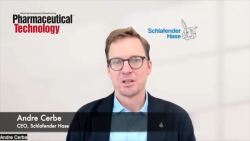
OR WAIT null SECS
- About Us
- Advertise
- Contact Us
- Editorial Info
- Editorial Advisory Board
- Do Not Sell My Personal Information
- Privacy Policy
- Terms and Conditions
© 2025 MJH Life Sciences™ , Pharmaceutical Technology - Pharma News and Development Insights. All rights reserved.
The Evolving Science Behind Formulation Development
This comprehensive overview of contemporary formulation strategies covers the drug product lifecycle from end to end, illustrating best practices for various formulation types seen through a CRDMO’s lens while also covering problem solving, the role of digital tools, and geopolitical changes.
Bringing new chemical entities (NCEs) from discovery all the way to the clinical trial stage requires deep knowledge in drug substance characterization, phase-appropriate formulations, and analytical development, not to mention the requisite technical capabilities necessary to deliver results that are at the same time tangible, practical, and innovative, all based on that expertise.
This article provides insight from Vaibhav Sihorkar, PhD, vice-president and Business Unit Head, Formulation Solutions at Aragen Life Sciences, about a world of new drug development he characterizes as dynamic and complex, while defining the range of services that a partner acting as a onestop solution can smoothly provide during the discovery to development pharmaceutics journey.
The role of the CRDMO
According to Sihorkar, contract research, development, and manufacturing organizations (CRDMOs) such as Aragen can offer a continuum of services to discovery clients from early discovery to the chemistry, manufacturing, and controls (CMC) process to clinical manufacturing. A CRDMO that has expertise in pre-formulation and formulation ideally can provide essential services that advance assets from lead identification through to clinical candidate selection.
“This includes pre-formulation strategies, such as selecting the optimal salt form, solid-state characterization (including polymorph screening), and improving solubility and oral bioavailability,” Sihorkar says, also adding excipient compatibility studies to this list. “The higher exposures needed for regulatory toxicity studies in preclinical rodent and non-rodent species are not only required to set the context for future human clinical doses but also help determine whether the NCE under consideration is developable and CMC-enabling, or CMC-challenging.”
Expanding on this theme, Sihorkar notes that whether a molecule in question is CMC-enabling or CMC-challenging, the CMC capabilities of a leading CRDMO should be designed to handle both. A holistic integration model, covering drug substance and drug product development alike, can ensure that formulation decisions are equally driven by scientific understanding and a seamless method of operational execution.
“Technologies such as spray drying allow for scalable formulation development from R&D to GMP [good manufacturing practice] manufacturing. These technology solutions are applied even to the most difficult compounds, including poorly soluble molecules known as ‘brick dusts,’” says Sihorkar, listing spray drying as one of Aragen’s key enabling technologies that works to overcome certain formulation challenges for poorly soluble NCEs. “A thorough evaluation of drug–polymer miscibility and drug loading is conducted to ensure molecular-level dispersion, as polymers play a critical role in stabilizing the amorphous drug. This stabilization reduces molecular mobility and increases the glass transition temperature, providing favorable viscoelastic behavior and enhancing resistance to devitrification and recrystallization.”
Support in the trial stage
Robust clinical drug product development, phase-appropriate analytical method creation, and clinical batch manufacturing including supplies for Phase I and II trials are offerings that can support clients’ needs, Sihorkar says, with insights from the entire development cycle—from pre-formulation to a developability assessment to identify clinical drug product strategy.
Sihorkar says that as NCEs progress to the first-in-human stage, companies design clinical drug product strategies to support Phase I and IIa studies, ensuring that drug products meet necessary specifications for manufacturability, stability, and quality.
“As the molecule advances through clinical development, we continue to optimize formulations for [Phase IIb and III] studies to enhance robustness and scalability, ensuring continued success in the clinic,” Sihorkar says. “These strategies may range from simple approaches like drug-in-bottle (DiB), drug-in-capsule (DiC), and conventional blends in capsules or tablets to more complex formats. such as multiparticulate, spray-dried, or roller-compacted, uncoated or coated solid dosage forms. These strategies are well-supported by phase-appropriate, validated analytical methods.”
Here again, Sihorkar says, an integrated development model can provide a fast, reliable path through CMC, with a full spectrum of support that allows clients to de-risk clinical entry and accelerate their timelines.
At the moment, Aragen says it is seeing the most activity in development and manufacturing, with client demand growing specifically for strategic formulation planning at some of the earliest points in the development cycle. Sihorkar says this is especially true when it comes to investigational new drug-enabling studies.
However, at the risk of stating the obvious, it should be noted that not all formulations are created equal.
Stability a main concern
“Indicators of a stable formulation include limited molecular mobility within the polymer matrix, strong drug–polymer interactions, and the absence of drug-rich domains that can act as nucleation sites for crystallization,” Sihorkar explains.
Optimizing spray drying parameters through design of experiments (DoE), Sihorkar says, can help control particle morphology, residual solvent content, and process yields. Each of these parameters influences physical stability and scalability in some way.
“Predictive tools, such as molecular dynamics simulations, can quantify diffusion coefficients and interaction energies to forecast maximum stable drug loading and identify potential pre-crystalline sites, offering early warnings of instability,” Sihorkar says. “Additionally, environmental factors like temperature and humidity must be carefully managed post-production to avoid plasticizing and crystallizing the amorphous solid dispersion (ASD).”
The integrated strategy of combining a mechanistic understanding of molecular mobility with advanced characterization and process control, according to Sihorkar, can help to ensure development of robust, stable ASDs that maximize poorly soluble NCE bioavailability.
In addition, such advanced technologies as atomic layer deposition (ALD)—a thin-film coating process—may assist in coating challenging compounds. ALD is typically used, Sihorkar says, to achieve precise, uniform, conformal coatings at the atomic scale, enhancing solubility, dissolution, and stability.
Advice for more challenging formulations
Certain hurdles are known to exist for complex molecules that may have, for instance, poor solubility, high dosage requirements, or stability concerns. Sihorkar says some of the tools, expertise, and technologies a company may leverage to address a particular compound’s biopharmaceutical and physical properties may include spray drying, nanosizing, hot-melt extrusion, lipid-based systems, multiparticulates, or long-acting injectables.
“For example, in the case of amorphous solid dispersions, we utilize knowledge such as thermal behavior, glass-forming ability, and understanding of glass transition and viscoelastic properties to ensure effective selection of polymers for dispersion and stability,” Sihorkar notes. “DoE methodologies are further employed to fine-tune parameters critical to scale-up, such as glass transition temperature elevation, stability from devitrification, particle size, and morphology.”
Meanwhile, micro- and nanotechnologies play pivotal roles, Sihorkar explains, in drug product development for poorly soluble NCEs, in terms of enhancing bioavailability and formulation performance, enabling production of fine, uniform particles or nanosuspensions that increase—by significant margins—surface area and dissolution rate, facilitating improved absorption whether a dosage form happens to be oral or injectable.
Some of the specific technologies commonly deployed in this realm include air jet milling, nano-milling, or high-pressure homogenization.
“Air jet milling offers a solvent-free, scalable approach to micronization, while nano-milling and high-pressure homogenization provide robust methods to achieve stable nanoscale dispersions with enhanced physical stability and controlled release profiles,” says Sihorkar. “Integrating these technologies early in drug development allows formulators to overcome solubility challenges, optimize pharmacokinetics, and ultimately deliver more effective therapies for difficult NCEs.”
Sihorkar adds that CRDMOs can be of use in tackling challenges of peptide formulation development, like proteolytic degradation and physical instability. In these cases, a CRDMO will design specialized strategies for improving oral bioavailability or enhancing absorption through alternative routes. The technologies that are typically offered in this area include nanostructured lipids, solid-lipid nanoparticles, liposomes, coated systems, or other types of approaches that enhance permeability.
Troubleshooting and rise of digital tools
Ensuring dependable workarounds for poorly soluble NCEs is an issue for which CRDMOs can plan their approach. But what about, for instance, when a compound consistently fails to achieve desired systemic exposure? That is a scenario in which Sihorkar says Aragen recently found itself with one of its clients, and it required a dedicated problem-solving effort.
With this particular compound, Sihorkar explains, prior attempts had been made by previous partners at micronization, nanosizing, and spray-dried dispersion. The properties of the molecule were reevaluated using a detailed molecular pharmaceutics approach and solid-state characterization, ultimately selecting an optimized polymer matrix that enhanced glass transition temperature and prevented crystallization.
From there, an improved spray-drying process helped reformulate the compound, achieving a greater than threefold increase in preclinical exposure and enabling the client to progress with regulatory toxicity studies and clinical manufacturing.
Other novel approaches to troubleshooting, as listed by Sihorkar, could include atomic layer deposition, lipid nanoparticles, and second-generation long-acting injectables to address, respectively, challenges of solubility, stability, and release.
It is in the development of things like long-acting injectables or stable peptide formulations where Sihorkar states that the collective mindset of an integrated CRDMO can ultimately prove to be of particular importance.
“These efforts culminate in a pharmaceutical developability assessment, which blends physicochemical properties, solid-state characteristics, biopharmaceutics, and excipient compatibility to ensure manufacturability for clinical studies,” he says.
But other items in the CRDMO toolbox can speed up separate elements of clinical drug product manufacturing, like decision-making and process optimization. Increasingly, this has meant such digital tools as predictive modeling, data-led formulation design, and digitized batch execution. Sihorkar says these approaches can improve efficiency, reduce cycle times, and engender a higher degree of reliability in product delivery.
One eye on global politics
Sihorkar concludes that companies partnering on formulation strategies must keep abreast of geopolitical developments. In the United States in 2025 specifically, that means not only changes to tariff policies enacted by President Donald Trump, but also ongoing congressional considerations of the BIOSECURE Act.
To be as proactive as possible about this, Sihorkar says, Aragen has recently introduced a dual-sourcing model by which critical raw materials—APIs and inactive ingredients alike, specialty excipients, consumables, and certain packaging, for instance—are provided by a number of suppliers in varying global locations.
Along with expanding vendor networks and enhancing digital supply chain monitoring systems, these are ways in which companies may look to mitigate risk in the current geopolitical climate. And not only that, according to Sihorkar, but taking steps such as these helps to ensure compliance as well as continuity in both clinical and commercial programs.
The unique combination of technical and domain expertise, plus cutting-edge technologies, that CRDMOs are able to provide affords the opportunity for end-to-end client solutions for NCE development, according to Sihorkar. For those clients, the ideal outcome is that their assets are supported effectively at each distinct stage of the drug development journey.
About the author
Patrick Lavery is an Editor for Pharmaceutical Technology®.
Article details
Pharmaceutical Technology®
Vol. 49, No. 7
September 2025
Pages: 10–13
Citation
When referring to this article, please cite it as Lavery, P. The Evolving Science Behind Formulation Development. Pharmaceutical Technology 2025 49 (7).

 Download Issue: Pharmaceutical Technology September 2025
Download Issue: Pharmaceutical Technology September 2025

